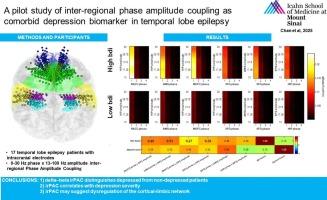A pilot study of inter-regional phase amplitude coupling as comorbid depression biomarker in temporal lobe epilepsy
IF 2.3
3区 医学
Q2 BEHAVIORAL SCIENCES
引用次数: 0
Abstract
Temporal lobe epilepsy (TLE) is associated with depression, but the neurobiological mechanisms underlying their bidirectional relationship remain unclear. Phase-amplitude coupling (PAC) refers to the interaction between the phase of low-frequency oscillations and the amplitude of high-frequency oscillations within the same brain signal, reflecting coordination between different brain rhythms for communication and cognitive processes. While prior studies, including our own, have explored PAC within individual brain regions, inter-regional PAC (irPAC) has not been studied in TLE and comorbid depression. We investigated irPAC in 17 TLE patients with electrodes implanted in the hippocampus, amygdala, and four cortical and subcortical regions (superior temporal, superior frontal, mesial orbitofrontal, and rostral anterior cingulate) in Papez circuit and default mode network. Modulation indices for directional brain region pairings were computed using a data-driven approach. Our analysis revealed a distinct delta–beta coupling signature that differentiated depressed from non-depressed TLE patients and correlated significantly with Beck Depression Inventory scores (Spearman’s ratio ∼ 0.5), with similar correlation strengths observed for seizure frequency in the Epilepsy Monitoring Unit. These findings suggest that aberrant inter-regional oscillatory interactions within limbic–cortical circuits may contribute to depression in epilepsy. The delta-beta irPAC signal may represent depression-related neural signatures that are distinct from general epilepsy network dysfunction. This work provides new insights into the interplay between epilepsy and depression in Papez circuit and default mode network.

区域间相振幅耦合作为颞叶癫痫共病抑郁生物标志物的初步研究
颞叶癫痫(TLE)与抑郁症有关,但其双向关系背后的神经生物学机制尚不清楚。相幅耦合(phase -amplitude coupling, PAC)是指同一大脑信号内低频振荡的相位与高频振荡的振幅之间的相互作用,反映了大脑在交流和认知过程中不同节律之间的协调。虽然之前的研究,包括我们自己的研究,已经探索了单个大脑区域内的PAC,但尚未研究TLE和共病抑郁症的区域间PAC (irPAC)。我们在17例TLE患者的Papez回路和默认模式网络中,分别在海马、杏仁核和四个皮层和皮层下区域(颞上、额上、眶额内侧和前扣带吻侧)植入电极,研究了irPAC。用数据驱动的方法计算脑区定向配对的调制指数。我们的分析揭示了一个明显的δ - β耦合特征,可以区分抑郁症和非抑郁症TLE患者,并与贝克抑郁量表评分(Spearman比值~ 0.5)显著相关,在癫痫监测单元中观察到的癫痫发作频率也具有类似的相关性。这些发现表明,边缘-皮层回路中异常的区域间振荡相互作用可能有助于癫痫患者的抑郁。δ - β irPAC信号可能代表与抑郁相关的神经特征,与一般癫痫网络功能障碍不同。本研究为癫痫与抑郁在Papez回路和默认模式网络中的相互作用提供了新的见解。
本文章由计算机程序翻译,如有差异,请以英文原文为准。
求助全文
约1分钟内获得全文
求助全文
来源期刊

Epilepsy & Behavior
医学-行为科学
CiteScore
5.40
自引率
15.40%
发文量
385
审稿时长
43 days
期刊介绍:
Epilepsy & Behavior is the fastest-growing international journal uniquely devoted to the rapid dissemination of the most current information available on the behavioral aspects of seizures and epilepsy.
Epilepsy & Behavior presents original peer-reviewed articles based on laboratory and clinical research. Topics are drawn from a variety of fields, including clinical neurology, neurosurgery, neuropsychiatry, neuropsychology, neurophysiology, neuropharmacology, and neuroimaging.
From September 2012 Epilepsy & Behavior stopped accepting Case Reports for publication in the journal. From this date authors who submit to Epilepsy & Behavior will be offered a transfer or asked to resubmit their Case Reports to its new sister journal, Epilepsy & Behavior Case Reports.
 求助内容:
求助内容: 应助结果提醒方式:
应助结果提醒方式:


